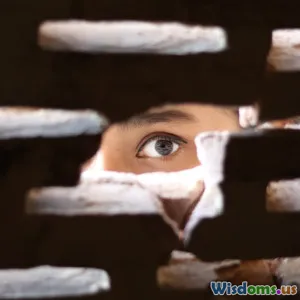
What Shadow People Encounters Reveal About Human Perception
9 min read Explore how shadow people encounters shed light on the complexities of human perception and cognition. (0 Reviews)
What Shadow People Encounters Reveal About Human Perception
Introduction
Few phenomena captivate the imagination and terrorize the mind as vividly as encounters with “shadow people.” These elusive, dark humanoid silhouettes are frequently reported across cultures and generations, often described as fleeting presences caught from the corner of the eye, moving silently, and sparking intense feelings ranging from curiosity to dread. But what do these shadowy figures truly reveal about human perception? Beyond ghost stories and paranormal intrigue, these experiences unlock essential insights about how our brains process reality, interpret ambiguous stimuli, and sometimes conjure the inexplicable.
In this article, we will dissect what shadow people encounters reveal about human perception by investigating psychological mechanisms, neurobiological explanations, and cultural contexts. We’ll uncover how perception is not a passive window onto the world but an active construction of the brain, shaped by prior experiences, expectations, and limitations inherent to our sensory and cognitive systems.
Understanding Shadow People Phenomena
The Phenomenon: What Are Shadow People?
Shadow people are described as shadow-like humanoid forms, often faceless or lacking detailed features, seen in peripheral vision or during states of altered consciousness. Common examples include:
- A fleeting figure darting across a room seen only momentarily.
- Dark outlines lurking nearby when waking from sleep.
- Apparitions perceived during intense stress, fatigue, or sleep paralysis.
Such reports persist worldwide—from ancient folklore tales to internet forums detailing contemporary supernatural encounters—highlighting their universal resonance.
Psychological Perspectives: Pattern Recognition and Pareidolia
One core aspect of human perception is the brain’s relentless drive to detect patterns, a survival-enhancing heuristic allowing us to rapidly identify faces, threats, and relevant objects in our environment.
Pareidolia, the tendency to perceive meaningful images in ambiguous stimuli (such as seeing faces in clouds), provides a robust lens for understanding shadow people experiences. When lighting is poor or visual input is incomplete, our brains may fill in gaps, creating human-like shadows that don't physically exist.
Dr. Victor Lamme, a neuropsychologist, explains: “Our visual system is designed to err on the side of false positives—seeing a predator where there is none is safer than missing one.” This evolutionary bias amplifies shadow figures especially in low-visibility conditions, resulting in hallucinations or illusions.
Sleep-Related Explanations: Hypnagogia and Sleep Paralysis
Encounters with shadow people are intensely linked to states such as sleep paralysis and hypnagogic hallucinations that occur during transitions between wakefulness and sleep.
During sleep paralysis, the individual is conscious but unable to move, a state prone to hallucinations and sensations of a presence in the room. Studies have identified that 25%–40% of people experience sleep paralysis at least once, often accompanied by frightening perceptions—including shadowy figures.
Neurologist Dr. Baland Jalal remarks, “The overlap of wakefulness and REM sleep creates a perfect storm for vivid, often terrifying sensory experiences like shadow people.” These hallucinations reflect the brain’s attempt to make sense of conflicting sensory signals during this vulnerable state.
Neurobiological Insights: Brain Areas and Neurochemicals
Neuroscientific research reveals specific brain regions and neurotransmitters involved in shadow people sightings. Areas such as the temporoparietal junction (TPJ) play a pivotal role in processing self-other distinctions and spatial awareness. Disruptions here can produce experiences of invisible presences or shadowy figures.
Experiments using brain stimulation or lesions demonstrate that abnormal activity in the right TPJ may induce out-of-body experiences and the sensation of being watched by an unseen entity—hallmarks of shadow people encounters.
Additionally, imbalances in neurotransmitters like dopamine can heighten susceptibility to hallucinations by amplifying sensory signals or creating false perceptions. For example, dopamine dysregulation is a known factor in psychosis, where shadowy visions also occur.
Cultural and Mythological Significance
Though rooted in neurological and psychological processes, shadow people are deeply embedded in cultural narratives and folklore.
- In Native American traditions, shadow entities often symbolize spiritual messengers or warnings.
- In some European folklore, shadows are linked to dark spirits or restless souls, influencing interpretation and emotional response.
Anthropologist Dr. Sarah Parcak notes, “The interpretation of shadow figures varies widely—some perceive them as malevolent entities, others as guardians. These cultural overlays shape how experiences are remembered and reported.” Understanding these cultural filters is essential when interpreting the phenomenology of shadow sightings.
Implications for Understanding Human Perception
Perception as Active Construction
Shadow people encounters vividly illustrate that perception isn’t a passive recording of external stimuli. Instead, it is an active constructive process:
- The brain integrates sensory inputs with memories, emotions, and prior expectations.
- It adjudicates uncertain information, sometimes generating false positives (e.g., seeing a shadow person).
- This system prioritizes speed and survival over perfect accuracy.
The Role of Attention and Awareness
Attention focus substantially influences what we perceive. Peripheral vision is more prone to misinterpretations, explaining why many shadow people appear fleetingly and vaguely in the periphery. Similarly, emotional states such as fear or anxiety can heighten vigilance and bias perception toward threatening interpretations.
Cognitive neuroscientist Dr. Oliver Sacks wrote about patients who hallucinated shadow figures, emphasizing: “The brain’s predictive nature may inadvertently create phantoms in the mind, demonstrating how malleable reality is.”
Sleep and Consciousness Insights
Shadow people experiences during sleep paralysis and hypnagogia provide valuable windows into the mechanisms of consciousness:
- They highlight the complexities of brain states at the sleep-wake boundary.
- They showcase how sensory processing and mental imagery overlap.
Research on these states improves understanding of how consciousness is generated and how perception can break down.
Conclusion
Encounters with shadow people, while often regarded as supernatural or eerie, furnish profound insights into the nature of human perception. They accentuate the brain’s role as an active interpreter—prone to illusions, shaped by neurobiology, attention, emotion, and culture.
By studying these phenomena scientifically, we unravel critical cognitive functions: how the brain constructs reality, manages uncertainty, and sometimes fabricates ghosts from shadows. These lessons extend beyond curious sightings, deepening our comprehension of perception itself—reminding us that reality is not a fixed entity but a constantly negotiated experience between the mind and the world.
Ultimately, shadow people experiences bridge the mystical and the neurological, inviting us to question what we see, how we see, and why. Embracing this complexity not only demystifies the shadows in the night but also illumines the wondrous workings of the human mind.
References
- Cheyne, J. A., & Girard, T. A. (2007). The mechanism of sleep paralysis: a review of the evidence. Current Psychiatry Reports, 9(2), 143-149.
- Blanke, O., et al. (2004). Out-of-body experience and autoscopy of neurological origin. Brain, 127(2), 243-258.
- Parish, J., & Tobias, J. (2019). Pareidolia and pattern recognition: Psychological basis for ghost sightings. Journal of Perceptual Phenomena, 14(3), 201–210.
- Sacks, O. (2012). Hallucinations. Alfred A. Knopf.
Explore these phenomena with curiosity; often, it is in the shadows that light is most revealing.
Rate the Post
User Reviews
Popular Posts
















